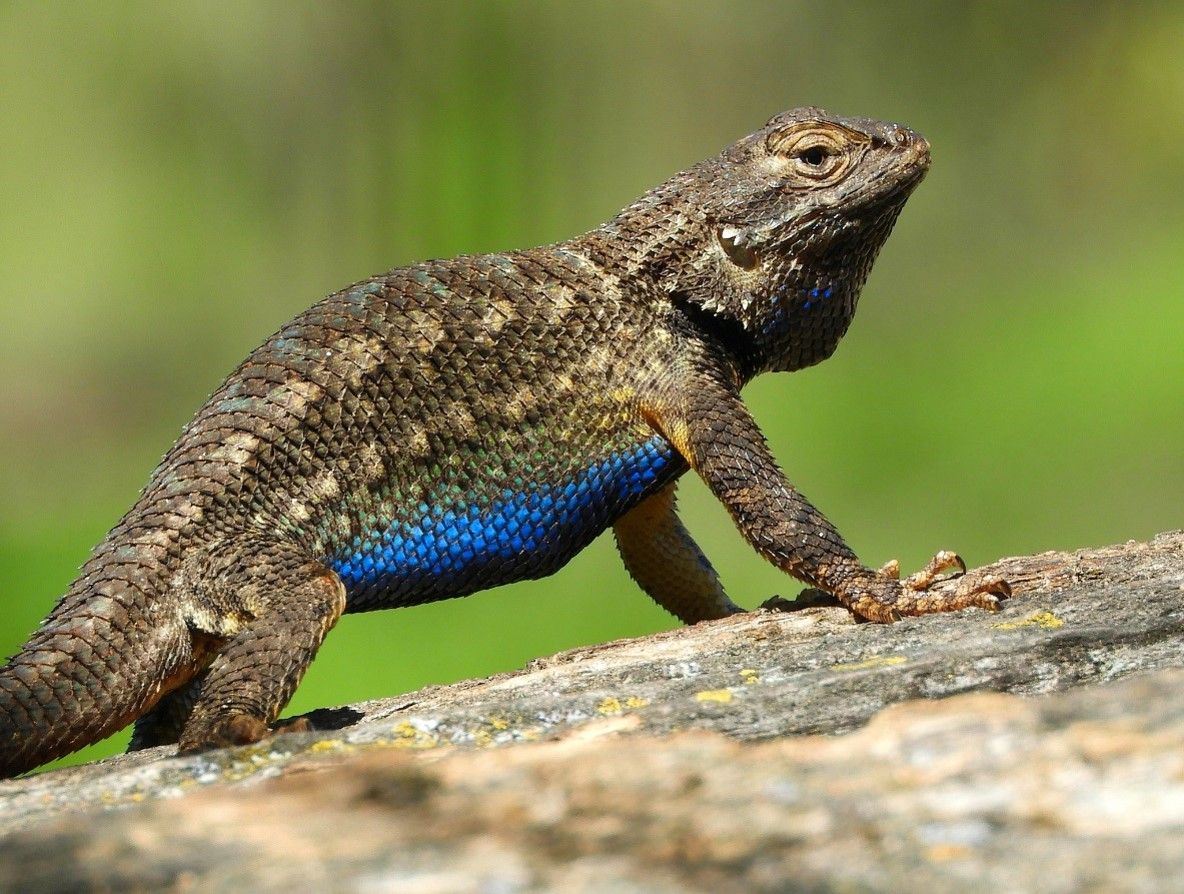Tuleyome's Science Corner - Western Fence Lizards

Western Fence Lizard (Sceloporus occidentalis)
The Western Fence Lizard (Sceloporus occidentalis) is a moderately sized lizard commonly found throughout the western United States from Eastern and Southwestern Oregon, Southwestern Idaho, Nevada, Western Utah, Arizona and Baja California from sea level to around 11,000 feet. They can be found in a variety of habitats within their range including woodlands, grasslands, chaparral, forests, and urban areas such as farmland and neighborhoods. They usually occur near water and do not occupy desert regions.
Lizards are commonly measured from snout to vent (STV) and Western Fence Lizards usually range from a little over two inches to about three and a half inches STV. This measurement does not include the tail as is common when measuring lizards because tail length of individuals can vary greatly. Coloration ranges from light to darker brown, gray or even jet black but it is believed that the color variation is less camouflage and more related to thermoregulation, the process that helps them maintain their core internal temperature. Because lizards are ectotherms (cold blooded), their body temperature depends on external heat sources such as sunlight itself or the surfaces of other things that are warm such as rocks or the ground. Western Fence Lizards are diurnal which means that they are active during the day and can often be seen in open, sunny areas basking in the sun on rocks, fallen trees, trail edges or fences. Because they like to bask in open areas, they are susceptible to predation and a cold lizard is a slow lizard - an easy snack for keen-sighted raptors and mammals.
They have sharp claws for climbing and their sharply pointed scales make them appear spiny. They have grayish stripes along the length of their body with a lighter sandy colored wave pattern going horizontally. You might have grown up calling Western Fence Lizards “blue bellies” for obvious reasons; the adult males have bright, blue bellies as well as blue patches on the underside of their necks. The blue is usually absent or very pale on females and juveniles which makes determining sex in adult lizards fairly easy. The shade of blue can range from almost shockingly blue to a lighter, pale blue. The undersides of the front and rear legs are yellow to orange and occasionally, lighter individuals can have some bright, iridescent turquoise blue scales on their backs. Males establish territories which usually includes higher areas where they can perch and keep an eye out for intruders. You may have seen them busting out a few pushups to threaten rival males (or maybe just a passerby) to keep them from their territory and they will engage in physical combat if the rival male does not heed the warning to stay away. Adult males also do pushups and bob their heads to show off their bright blue patches to impress females. Courtship and mating usually occur from March through July and females can lay up to three clutches of up to nearly 20 eggs. The eggs are laid in shallow depressions dug by the female in loose, moist soil and begin hatching in August. Keep an eye out around that time and you will probably start seeing teeny tiny little two-inch baby Western Fence Lizards scurrying for the nearest safe place. Most of them do not breed until their second spring and individuals can live from five to seven years in the wild if things go well for them.
Western Fence Lizards eat a variety of invertebrates such as spiders, caterpillars, crickets, grasshoppers, mosquitoes and sometimes even their own babies.
If their tail is nabbed by a predator, they can detach it in an attempt to escape. The discarded tail continues to wiggle which will hopefully distract the predator enough so the lizard can escape. The tail usually grows back in about a month but is almost always shorter and will have a different scale pattern. Although this may save the lizard’s life, it is very costly and stressful for them.
It’s been discovered that Western Fence Lizards have an immunity to Lyme disease. They have a protein in their blood that kills the bacteria that causes Lyme disease. When ticks carrying the bacteria feed on a Western Fence Lizard, the protein kills the bacteria in the tick’s gut and the tick can no longer spread the disease. It’s been shown that cases of Lyme disease are fewer in areas occupied by Western Fence Lizards. Pretty cool.
-Kristie Ehrhardt (kehrhardt@tuleyome.org)
Tuleyome Land Conservation Program Manager
RECENT ARTICLES






